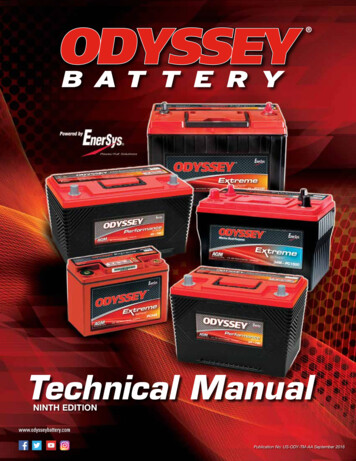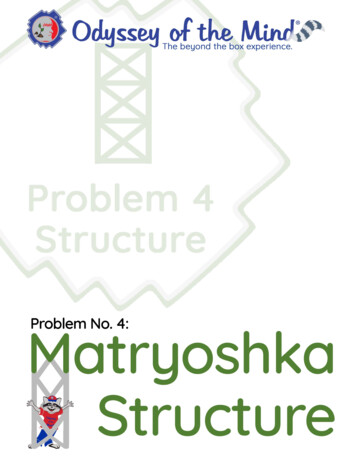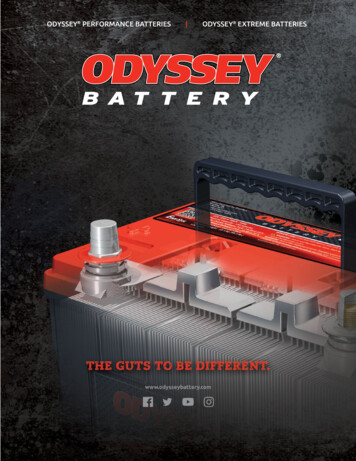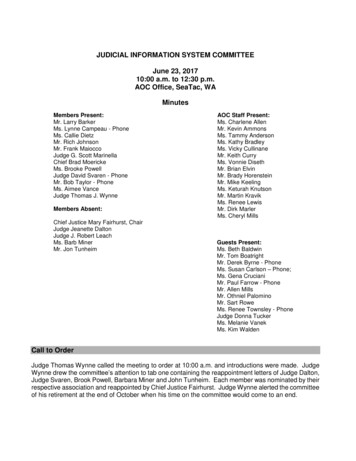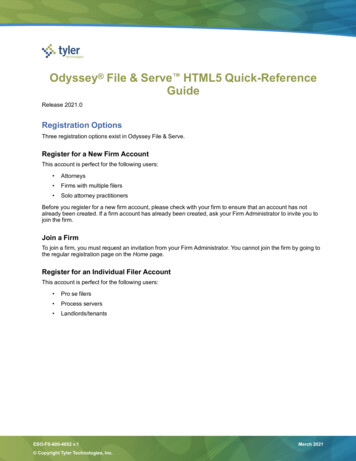
Transcription
Western Blot AnalysisDeveloped for:Odyssey Family of ImagersPlease refer to your manual to confirm that this protocol is appropriate forthe applications compatible with your model of Odyssey Imager. Published 2003. Revised February 2011.The most recent version of this protocolis posted at: http://biosupport.licor.com
Page 2 — Western Blot AnalysisContentsPageI.Required Reagents.2II.III.IV.V.VI.VII.VIII.Western Detection Methods.3Guidelines for Two-Color Detection .5Stripping the Membrane .6Adapting Western Blotting Protocols for Odyssey Detection.6General Tips .8Imaging of Coomassie-Stained Protein Gels.8Troubleshooting Guide.9I. Required Reagents Blotted nitrocellulose (LI-COR, P/N 926-31090)or low-fluorescent PVDF membrane (LI-COR, P/N 926-31098)Odyssey Blocking Buffer (LI-COR, P/N 927-40000)Primary antibodiesInfrared IRDye secondary antibodies (LI-COR)Tween 20PBS wash buffer (LI-COR, P/N 928-40018 or 928-40020)Ultrapure waterMethanol for wetting of PVDFSDS (if desired)Other blocking buffers (if desired)NewBlot Stripping Buffer, if desired, for nitrocellulose (LI-COR, P/N 928-40030)or PVDF (LI-COR, P/N 928-40032) membranesFluorescent Dyes Appropriate for Use with the Odyssey SystemDyeIRDye 800CWIRDye 680LTIRDye 680IRDye 700DXAlexa Fluor 680Alexa Fluor 700Alexa Fluor 750Alexa Fluor 647Cy 5.5Cy5Sensitivity Odyssey Channel800700700700700700700/800 (not recommended; signal appears in both channels)700700700The most current information on dye compatibility can be found on the LI-COR website (www.licor.com).
Western Blot Analysis — Page 3II. Western Detection MethodsNitrocellulose or PVDF membranes may be used for protein blotting. Pure cast nitrocellulose isgenerally preferable to supported nitrocellulose. Protein should be transferred from gel to membrane by standard procedures. Membranes should be handled only by their edges, with clean forceps.After transfer, perform the following steps:1.Wet the membrane in PBS for several minutes. If using a PVDF membrane that has beenallowed to dry, pre-wet briefly in 100% methanol and rinse with ultrapure water beforeincubating in PBS.Notes: Ink from most pens and markers will fluoresce on the Odyssey Imagers. The ink may wash offand re-deposit elsewhere on the membrane, creating blotches and streaks. Pencil should be usedto mark membranes. (The Odyssey pen doesn’t fluoresce and can be used with nitrocellulosemembranes, since the membrane will not be soaked in methanol causing the ink to run.)2.Block the membrane in Odyssey Blocking Buffer for 1 hour. Be sure to use sufficientblocking buffer to cover the membrane (a minimum of 0.4 mL/cm2 is suggested).Notes: Membranes can be blocked overnight at 4 C if desired. Odyssey Blocking Buffer often yields higher and more consistent sensitivity and performancethan other blockers. Nonfat dry milk or casein dissolved in PBS can also be used for blocking andantibody dilution, but be aware that milk may cause higher background on PVDF membranes. Ifusing casein, a 0.1% solution in 0.2X PBS buffer is recommended (Hammersten-grade casein isnot required). Milk-based reagents can interfere with detection when using anti-goat antibodies. They also deteriorate rapidly at 4 C, so diluted antibodies cannot be kept and re-used for more than a few days. Blocking solutions containing BSA can be used, but in some cases they may cause high membrane background. BSA-containing blockers are not generally recommended and should be usedonly when the primary antibody requires BSA as blocker.3.Dilute primary antibody in Odyssey Blocking Buffer. Optimum dilution depends on theantibody and should be determined empirically. A suggested starting range can usuallybe found in the product information from the vendor. To lower background, add 0.1 - 0.2%Tween 20 to the diluted antibody before incubation. The optimum Tween 20concentration will depend on the antibody.Notes: Two-color detection requires careful selection of primary and secondary antibodies. For details,see III. Guidelines for Two Color Western Detection. The MPX Blotting System can be used to efficiently determine the optimum antibody concentration. For details, see One Blot Western Optimization Using the MPX Blotting System (979-10184) athttp://biosupport.licor.com.4.Incubate blot in primary antibody for 60 minutes or longer at room temperature withgentle shaking. Optimum incubation times vary for different primary antibodies. Useenough antibody solution to completely cover the membrane.5.Wash membrane 4 times for 5 minutes each at room temperature in PBS 0.1% Tween 20with gentle shaking, using a generous amount of buffer.
Page 4 — Western Blot Analysis6.Dilute the fluorescently-labeled secondary antibody in Odyssey Blocking Buffer. Avoidprolonged exposure of the antibody vial to light. Recommended dilution can be found inthe pack insert for the IRDye conjugate. Add the same amount of Tween 20 to the dilutedsecondary antibody as was added to the primary antibody.Notes: For detection of small amounts of protein, try using more secondary antibody (1:5000-1:10,000dilution). Be careful not to introduce contamination into the antibody vial. Diluted secondary antibody can be saved and re-used. Store at 4 C and protect from light. However, for best sensitivity and performance, use freshly diluted antibody solution. Adding 0.01% - 0.02% SDS to the diluted secondary antibody (in addition to Tween 20) will substantially reduce membrane background, particularly when using PVDF. However, DO NOT addSDS during blocking or to the diluted primary antibody. See V. Adapting Western Blotting Protocolsfor Odyssey Detection for more information about how and why to use SDS in the secondary antibody incubation. The MPX Blotting System can be used to efficiently determine the optimum antibody concentration. For details, see One Blot Western Optimization Using the MPX Blotting System (979-10184) athttp://biosupport.licor.com.7.Incubate blot in secondary antibody for 30-60 minutes at room temperature with gentleshaking. Protect from light during incubation.Notes: Incubating more than 60 minutes may increase background.8.Wash membrane 4 times for 5 minutes each at room temperature in PBS 0.1% Tween 20with gentle shaking. Protect from light.9.Rinse membrane with PBS to remove residual Tween 20. The membrane is now ready toscan.Notes: Scan in the appropriate channels (see I. Required Reagents for details). Protect the membrane from light until it has been scanned. Keep the membrane wet to strip and re-use it. Once a membrane has dried, stripping is ineffective. Blots can be allowed to dry before scanning if desired. Signal strength may be enhanced on a drymembrane. The membrane can also be re-wetted for scanning. The fluorescent signal on the membrane will remain stable for several months, or longer, if protected from light. Membranes may be stored dry or in PBS buffer at 4 C. If signal on membrane is too strong or too weak, re-scan the membrane at a lower or higher scanintensity setting, respectively.Molecular Weight MarkerIf you loaded the Odyssey Prestained Molecular Weight Marker (LI-COR, P/N 928-40000), it will bevisible in the 700 nm channel and also faintly visible in the 800 nm channel. If the marker is subjected to numerous freeze/thaw cycles, it may degrade. This is observed as multiple, high-molecular weight bands appearing in the 800 nm channel. If this occurs, discard the aliquot and use afresh one.
Western Blot Analysis — Page 5Prestained blue molecular weight markers from other sources can also be used. Load 1/3 to 1/5 ofthe amount you would normally use for Western transfer. Too much marker can result in verystrong marker bands that may interfere with visualization of sample lanes. If using multicoloredmarkers, some bands may not be visualized.Optimization Tips Follow the protocol carefully. No single blocking reagent will be optimal for every antigen-antibody pair. Some primaryantibodies may exhibit greatly reduced signal or different non-specific binding in different blockingsolutions. If it is difficult to detect the target protein, changing the blocking solution maydramatically improve performance. If the primary antibody has worked well in the past usingchemiluminescent detection, try that blocking solution for infrared detection. Addition of detergent such as Tween 20 can reduce membrane background and non-specificbinding. Refer to V. Adapting Western Blotting Protocols for Odyssey Detection for details. To avoid background speckles on blots, use ultrapure water for buffers and rinse plastic dishes wellbefore and after use. Never perform Western incubations or washes in dishes that have been usedfor Coomassie staining. Membranes should be handled only by their edges, with clean forceps. After handling membranes that have been incubating in antibody solutions, clean forcepsthoroughly with distilled water and/or ethanol. If forceps are not cleaned after being dipped inantibody solutions, they can cause spots or streaks of fluorescence on the membrane that aredifficult to wash away. Do not wrap the membrane in plastic when scanning. If a Western blot will be stripped, do not allow the membrane to dry. Stripping is ineffective once amembrane has dried, or even partially dried.III. Guidelines for Two-Color DetectionTwo different antigens can be detected simultaneously on the same blot using antibodies labeledwith IR dyes that are visualized in different fluorescence channels (700 and 800 nm). Two-colordetection requires careful selection of primary and secondary antibodies.The following guidelines will help design two-color experiments: If the two primary antibodies are derived from different host species (for example, primaryantibodies from mouse and chicken), IRDye whole IgG secondary antibodies derived from thesame host and labeled with different IRDye fluorophores must be used (for example, IRDye 800CWDonkey anti-Mouse and IRDye 680LT Donkey anti-Chicken). If the two primary antibodies are monoclonals (mouse) and are IgG1, IgG2a, or IgG2b, IRDyeSubclass Specific secondary antibodies must be used. The same subclasses cannot be combined ina two-color Western blot (for example, two IgG1 primary antibodies). For details refer to WesternBlot and In-Cell Western Assay Detection Using IRDye Subclass Specific Antibodies). Before combining primary antibodies in a two-color experiment, always perform preliminary blotswith each primary antibody alone to determine the expected banding pattern and possiblebackground bands. Slight cross-reactivity may occur and can complicate interpretation of a blot,particularly if the antigen is very abundant. If cross-reactivity is a problem, load less protein orreduce the amount of antibody.
Page 6 — Western Blot Analysis One secondary antibody must be labeled with a 700 channel dye, and the other with an 800 channeldye. For a list of fluorescent dyes and the channels where they can be visualized, see I. RequiredReagents. Always use highly cross-adsorbed secondary antibodies for two-color detection. Failure to usehighly cross-adsorbed antibodies may result in cross-reactivity. For best results, avoid using primary antibodies from mouse and rat together for a two-colorexperiment. It is not possible to completely adsorb away cross-reactivity because the species areso closely related. If using mouse and rat together, it is crucial to run single-color blots first witheach individual antibody to be certain of expected band sizes.When performing a two-color blot, use the standard Western blot protocol with the following modifications: Combine the two primary antibodies in the diluted antibody solution in step 3. Incubate simultaneously with the membrane (step 4). Combine the two dye-labeled secondary antibodies in the diluted antibody solution in step 6.Incubate simultaneously with the membrane (step 7).IV. Stripping the MembraneTypically, both PVDF and nitrocellulose membranes can be stripped up to three times. LI-COR NewBlot Stripping Buffer is available under P/N 928-40030 for nitrocellulose or 928-40032 for PVDF. Ifa blot is to be stripped, DO NOT allow it to dry before, during, or after imaging (keep the blot aswet as possible). Complete usage instructions are given in the NewBlot Stripping Buffer pack insertthat is shipped with the product. Before proceeding, read the instructions in the pack insert, including the frequently asked questions.V. Adapting Western Blotting Protocols forOdyssey DetectionWhen adapting Western blotting protocols for Odyssey detection or using a new primary antibody, it is important to determine the optimal antibody concentrations. Optimization will helpachieve maximum sensitivity and consistency. Three parameters should be optimized: primaryantibody concentration, dye-labeled secondary antibody concentration, and detergent concentration in the diluted antibodies.Primary Antibody ConcentrationPrimary antibodies vary widely in quality, affinity, and concentration. The correct working rangefor antibody dilution depends on the characteristics of the primary antibody and the amount oftarget antigen to detect. Suggested dilutions are 1:500, 1:1500, 1:5000, and 1:10,000 (start withthe dilution factor normally used for chemiluminescent detection, and also refer to the productinformation from the vendor). Use the MPX Blotting System to optimize the primary dilution toachieve maximum performance and conserve antibody (refer to One Blot Western Optimization Usingthe MPX Blotting System at http://biosupport.licor.com).
Western Blot Analysis — Page 7Secondary Antibody ConcentrationOptimal dilutions of dye-conjugated secondary antibodies should also be determined. Suggestedstarting dilutions to test are 1:5000, 1:10,000, and 1:20,000 (refer to the IRDye conjugate packinsert for recommendations). The amount of secondary required varies depending on how muchantigen is being detected – abundant proteins with strong signals require less secondary antibody. Use the MPX Blotting system to optimize (refer to One Blot Western Optimization Using the MPXBlotting System at http://biosupport.licor.com).Detergent ConcentrationAddition of detergents to diluted antibodies can significantly reduce background on the blot. Optimal detergent concentration will vary, depending on the antibodies, membrane type, and blockerused. Keep in mind that some primaries do not bind as tightly as others and may be washed awayby too much detergent. Never expose the membrane to detergent until blocking is complete, asthis may cause high membrane background.Tween 20: Add Tween 20 to both the primary antibody and secondary antibody solutions when the antibodies are diluted in blocking buffer. A final concentration of 0.1 - 0.2% is recommended fornitrocellulose membranes, and a final concentration of 0.1% is recommended for PVDF membranes (higher concentrations of Tween 20 may actually cause increased background on PVDF). Wash solutions should contain 0.1% Tween 20.SDS: Adding 0.01 - 0.02% SDS to the diluted secondary antibody can dramatically reduce overallmembrane background and also reduce or eliminate non-specific binding. It is critical to useonly a very small amount, because SDS is an ionic detergent and can disrupt antigen-antibodyinteractions if too much is present at any time during the detection process. Addition of SDS is particularly helpful for reducing the higher overall background that is seenwith PVDF membrane. When working with IRDye 680LT conjugates on PVDF membranes, SDS(final concentration of 0.01 - 0.02%) and Tween 20 (final concentration of 0.1 - 0.2%) must beadded during detection incubation step to avoid non-specific background staining. DO NOT add SDS during the blocking step or to the diluted primary antibody. Presence of SDSduring binding of the primary antibody to its antigen may greatly reduce signal. Add SDS onlyto the diluted secondary antibody. When diluting the dye-labeled secondary antibody in blocking buffer, add both 0.1 - 0.2% Tween20 and 0.01 - 0.02% SDS to the antibody solution. Wash solutions should contain 0.1% Tween 20, but no SDS. Some antibody-antigen pairs may be more sensitive to the presence of SDS and may requireeven lower concentrations of this detergent (less than 0.01%) for best performance. Titrate theamount of SDS to find the best level for the antibodies used. If high background is seen when using BSA-containing blocking buffers, adding SDS to the secondary antibody may alleviate the problem.
Page 8 — Western Blot AnalysisVI. General Tips Milk-based blockers may contain IgG that can cross-react with anti-goat antibodies. This cansignificantly increase background and reduce antibody titer. Milk may also contain endogenousbiotin or phospho-epitopes that can cause higher background. Store the IRDye secondary antibody vial at 4 C in the dark. Do not thaw and refreeze the vial, asthis will affect antibody performance. Minimize exposure to light and take care not to introducecontamination into the vial. Dilute immediately prior to use. If particulates are seen in the antibodysolution, centrifuge before use. Protect membrane from light during secondary antibody incubations and washes. Use the narrowest well size possible for the loading volume to concentrate the target protein. The best transfer conditions, membrane, and blocking agent for experiments will vary, dependingon the antigen and antibody. If there is high background or low signal level, a good first step is totry a different blocking solution. Small amounts of purified protein may not transfer well. Adding non-specific proteins of similarmolecular weight can have a “carrier” effect and substantially increase transfer efficiency. For proteins 100 kDa, try blotting in standard Tris-glycine buffer with 20% methanol and no SDS.Addition of SDS to the transfer buffer can greatly reduce binding of transferred proteins to themembrane (for both PVDF and nitrocellulose). Soak the gel in transfer buffer for 10-20 minutes before setting up the transfer. Soaking equilibratesthe gel and removes buffer salts that will be carried over into the transfer tank. To maximize retention of transferred proteins on the membrane, allow the membrane to air-drycompletely after transfer (approximately 1-2 hours). Do not over-block. Long blocking incubations, particularly with nonfat dry milk at 2% or higher, cancause loss of target protein from the membrane (J. Immunol. Meth. 122:129-135, 1989). To enhance signal, try extended primary antibody incubation at room temperature or overnightincubation at 4 C. Avoid extended incubations in secondary antibody.VII. Imaging of Coomassie-Stained Protein GelsIRDye Blue Protein Stain is a convenient, safe alternative for gel staining to provide confirmationof protein transfer to the membrane. Unlike traditional Coomassie Blue stains, which requiremethanol and acetic acid for staining and destaining, IRDye Blue Protein Stain is water-based andrequires no hazardous solvents. This stain offers excellent detection sensitivity in the 700 nm channel of the Odyssey imaging systems ( 5 ng of BSA can be detected). IRDye Blue Protein Stain isCoomassie-based and is provided as a ready-to-use 1X solution. Prewashing and destaining stepsare performed in water.1.Wash gels with ultrapure water for 15 minutes.2.Submerge gel in IRDye Blue Stain for 1 hour.3.Destain with ultrapure water for 30 minutes or overnight if needed.4.Scan on an Odyssey imaging system in the 700 nm channel only. If using the Odysseysoftware, select the Protein Gel scan preset. If using the Odyssey Sa software, set thefocus offset to 3.0 plus one-half the thickness of the gel. In Image Studio, select Western.
Western Blot Analysis — Page 9VIII. Troubleshooting GuideProblemHigh background, uniformly distributed.Possible CauseSolution / PreventionBSA used for blocking.Blocking solutions containing BSA maycause high membrane background.Try adding SDS to reduce background,or switch to a different blocker.Not using optimal blockingreagent.Compare different blocking buffers tofind the most effective; try blocking longer.Background on nitrocellulose.Add Tween 20 to the diluted antibodies to reduce background. Try addingSDS to diluted secondary antibody.Background on PVDF.Use low-fluorescent PVDF membrane.With IRDye 680LT conjugates, alwaysuse SDS (0.01-0.02% final concentration) and Tween 20 (0.1-0.2% final) during the detection incubation step.Antibody concentrations toohigh.Optimize primary and secondary antibody dilutions using MPX blottingsystem. For details, see One Blot Western Optimization Using the MPX BlottingSystem at http://biosupport.licor.com.Insufficient washing.Increase number of washes and buffervolume.Make sure that 0.1% Tween 20 is present in buffer and increase if needed.Note that excess Tween 20 (0.5-1%)may decrease signal.Cross-reactivity of antibody withcontaminants in blocking buffer.Use Odyssey Blocking Buffer instead ofmilk. Milk is usually contaminated withIgG and will cross-react with anti-goatsecondary antibodies.Inadequate antibody volumeused.Increase antibody volume so entiremembrane surface is sufficiently covered with liquid at all times (use heatseal bags if volume is limiting). Do notallow any area of membrane to dry out.Use agitation for all antibody incubations.Membrane contamination.Always handle membranes carefullyand with clean forceps. Do not allowmembrane to dry. Use clean dishes,bags, or trays for incubations.
Page 10 — Western Blot AnalysisProblemUneven blotchy or speckled background.Possible CauseSolution / PreventionBlocking multiple membranestogether in small volume.If multiple membranes are beingblocked in the same dish, ensure thatblocker volume is adequate for allmembranes to move freely and makecontact with liquid.Membrane not fully wetted orallowed to partially dry.Keep membrane completely wet at alltimes. This is particularly crucial if blotwill be stripped and re-used.If using PVDF, remember to first prewet in 100% methanol.Contaminated forceps or dishes.Always carefully clean forceps afterthey are dipped into an antibody solution, particularly dye-labeled secondaryantibody. Dirty forceps can deposit dyeon the membrane that will not washaway.Use clean dishes, bags or trays forincubations.Weak or no signal.Dirty scanning surface or silicone mat.Clean scanning surface and mat carefully before each use. Dust, lint, andresidue will cause speckles.Incompatible marker or penused to mark membrane.Use only pencil or Odyssey pen (nitrocellulose only) to mark membranes.Not using optimal blockingreagent.Primary antibody may perform substantially better with a different blocker.Insufficient antibody used.Primary antibody may be of low affinity. Increase amount of antibody or trya different source.Extend primary antibody incubationtime (try 4 - 8 hr at room temperature,or overnight at 4 C).Increase amount of primary or secondary antibody, optimizing for best performance.Try substituting a different dye-labeledsecondary antibody.Primary or secondary antibody mayhave lost reactivity due to age or storage conditions.
Western Blot Analysis — Page 11ProblemWeak or no signal(continued)Possible CauseSolution / PreventionToo much detergent present; signal being washed away.Decrease Tween 20 and/or SDS indiluted antibodies. Recommended SDSconcentration is 0.01 - 0.02%, but someantibodies may require an even lowerconcentration.Insufficient antigen loaded.Load more protein on the gel. Try usingthe narrowest possible well size to concentrate antigen.Protein did not transfer well.Check transfer buffer choice and blotting procedure.Use pre-stained molecular weightmarker to monitor transfer, and staingel after transfer to make sure proteinsare not retained in gel.Protein lost from membrane during detection.Extended blocking times or high concentrations of detergent in diluted antibodies may cause loss of antigen fromthe blotted membrane.Proteins not retained on membrane during transfer.Allow membrane to air dry completely(1 - 2 hr) after transfer. This helps makethe binding irreversible.Addition of 20% methanol to transferbuffer may improve antigen binding.Note: Methanol decreases pore size ofgel and can hamper transfer of largeproteins.SDS in transfer buffer may interferewith binding of transferred proteins,especially for low molecular weightproteins. Try reducing or eliminatingSDS. Note: Presence of up to 0.05%SDS does improve transfer efficiency ofsome proteins.Small proteins may pass throughmembrane during transfer (“blowthrough”). Use membrane with smallerpore size or reduce transfer time.
Page 12 — Western Blot AnalysisProblemPossible CauseNon-specific orunexpected bands.Antibody concentrations toohigh.Solution / PreventionReduce the amount of antibody used.Reduce antibody incubation times.Increase Tween 20 in diluted antibodies.Add or increase SDS in diluted secondary antibodies.Not using optimal blockingreagent.Choice of blocker may affect backgroundbands. Try a different blocker.Cross-reactivity between antibodies in a two-color experiment.Double-check the sources and specificities of the primary and secondary antibodies used (see III. Guidelines forTwo-Color Detection).Use only highly cross-adsorbed secondary antibodies.There is always potential for crossreactivity in two-color experiments. Useless secondary antibody to minimizethis.Always test the two colors on separateblots first so you know what bands toexpect and where.Avoid using mouse and rat antibodiestogether, if possible. Because the species are so closely related, anti-mousewill react with rat IgG to some extent,and anti-rat with mouse IgG. Sheepand goat antibodies may exhibit thesame behavior.Bleedthrough of signal from onechannel into other channel.Check the fluorescent dye used. Fluorophores such as Alexa Fluor 750 mayappear in both channels and are notrecommended for use with theOdyssey Imaging Systems.If signal in one channel is very strong(near or at saturation), it may generatea small amount of bleedthrough signalin the other channel. Minimize this byusing a lower scan intensity setting inthe problem channel.Reduce signal by reducing the amountof protein loaded or antibody used.4647 Superior Street P.O. Box 4000 Lincoln, Nebraska 68504 USATechnical Support: 800-645-4260 North America: 800-645-4267International: 402-467-0700 402-467-0819LI-COR GmbH, Germany (Serving Europe, Middle East, and Africa): 49 (0) 6172 17 17 771LI-COR UK Ltd., UK (Serving UK, Ireland, and Scandinavia): 44 (0) 1223 422104All other countries, contact LI-COR Biosciences or a local LI-COR distributor: OR Biosciences is an ISO 9001 registered company. 2011 LI-COR, Inc. LI-COR, Odyssey, NewBlot, MPX, In-Cell Western, and IRDye are trademarksor registered trademarks of LI-COR, Inc. in the United States and other countries. All other trademarks belong to their respective owners. The OdysseyImaging Systems and IRDye reagents are covered by U.S. patents, foreign equivalents, and patents pending. 988-11873 02/11
Good Westerns Gone Bad:Tips to Make Your NIR Western Blot GreatDeveloped for:Odyssey Family of ImagersPlease refer to your manualto confirm that this protocolis appropriate for theapplications compatiblewith your model ofOdyssey Imager.Published December 2008. RevisedMarch 2011. The most recentversion of this document is posted athttp://biosupport.licor.com
Page 2 – Good Westerns Gone BadContentsI.II.III.IV.V.VI.VII.PagesIntroduction to Western Blotting . . . . . . . . . . . . . . . . . . . . . . . . . . . . . . . . . . .2Factors That Alter the Performance of a Western Blot . . . . . . . . . . . . . . . . . . .2Scanning Issues That Can Alter the Performance of a Western Blot . . . . . . . .10Data Analysis Using the Odyssey Infrared Imaging System . . . . . . . . . . . . .12Data Analysis Using the Odyssey Fc Imaging System . . . . . . . . . . . . . . . . .12Summary . . . . . . . . . . . . . . . . . . . . . . . . . . . . . . . . . . . . . . . . . . . . . . . . . . . .12References . . . . . . . . . . . . . . . . . . . . . . . . . . . . . . . . . . . . . . . . . . . . . . . . . .12I. Introduction to Western BlottingWestern blotting is used to positively identify a protein from a complex mixture. It was first introduced byTowbin, et al. in 1979 as a simple method of electrophoretic blotting of proteins to nitrocellulose sheets.Since then, Western blotting methods for immobilizing proteins onto a membrane have become a commonlaboratory technique. Although many alterations to the original protocol have also been made, the generalpremise still exists. Macromolecules are separated using gel electrophoresis and transferred to a membrane,typically nitrocellulose or polyvinylidene fluoride (PVDF). The membrane is blocked to prevent non-specificbinding of antibodies and probed with some form of detection antibody or conjugate.Infrared fluorescence detection on the Odyssey Imaging System provides a quantitative two-color detectionmethod for Western Blots. This document will discuss some of the factors that may alter the performance of anear-infrared (IR) Western blot, resulting in “good Westerns, gone bad.”II. Factors That Alter the Performance of a Western BlotA. MembraneA low background membrane is essential for IR West
a two-color Western blot (for example, two IgG1 primary antibodies). For details refer to Western Blot and In-Cell Western Assay Detection Using IRDye Subclass Specific Antibodies). Before combining primary antibodies in a two-color experiment, always perform preliminary blots
